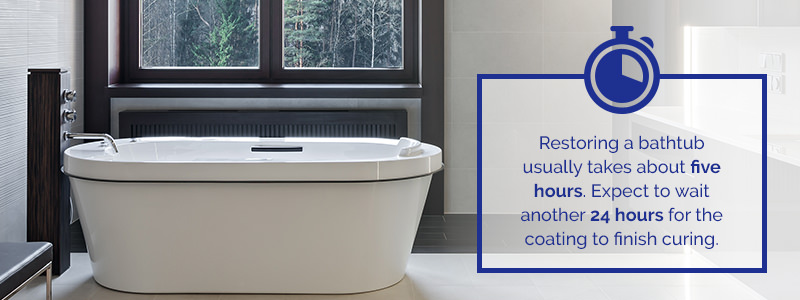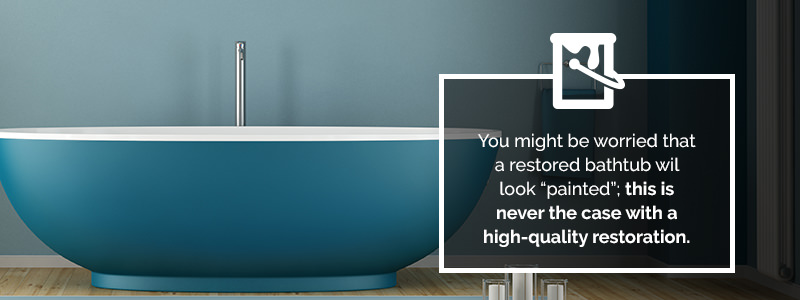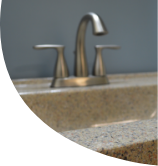Is a Bathtub Liner a Good Idea?
The average bathtub can last twenty years, but the wear and tear of daily life usually take a toll much earlier than that. Chips in the enamel, hard water stains, and rust all play a role in making your bathtub look drab. And as the biggest feature in your bathroom, a worn-out bathtub can have a serious impact on your bathroom’s appeal.
So what do you do with a beaten-up bathtub? To spruce up their bathroom, many homeowners consider one of three options:
- Replacing the bathtub
- Refinishing the bathtub
- Installing a bathtub liner
At first glance, installing a new bathtub seems like the easiest option. Unfortunately, many homeowners soon find out that it’s not. Bathtubs are usually installed when a home is built. The plumbing is usually designed for a specific tub, and the tile surrounds are placed once the tub is built. Installing a new tub means removing the tile and reworking the plumbing. If the new bathtub has different dimensions, you may have additional construction costs.
All of this can add significant costs to your project. Although a new bathtub usually costs just a few hundred dollars, the installation can add several thousand to your project.
Installing a new bathtub can be a great choice if you’re remodeling your bathroom. If you plan to replace tile or tub surrounds anyway, you’ll see a good return on your investment for installing a new tub when you remodel.
But what if you’re not planning a full bathroom remodel?
If you’re not planning to make other changes, you may find that installing a new bathtub will involve more construction than you want. Luckily, there are other alternatives for your tub.
Restoring your bathtub or installing a bathtub liner are both options for getting an attractive bathtub without the work of a remodel. We recommend restoring your tub instead of using a bathtub liner, because more it’s hygienic and lasts considerably longer. However, both options will give your worn-out tub a facelift.
What is a bathtub restoration?
Restoring a bathtub is a simple process. The outer surface on the bathtub, where chips, water stains and other types of damage occur, is removed. We sand down the surface of the tub, then resurface it with a special paint designed for bathtubs. Restoring a bathtub usually takes about five hours. Expect to wait another one to twelve hours for the coating to finish drying. Steel, cast iron and fiberglass bathtubs can all be restored.

Restoring a bathtub can be a do-it-yourself project, but for the best results, find a well-regarded professional. Inexperienced restorers can leave bubbles in the paint or create a sticky, etched surface. Professional restorers get the job done faster. They also have professional ventilation equipment designed for the project, which keeps your home free of chemical odors.
Advantages of Restoring a Bathtub:
- Long life: A restored bathtub can last another ten to fifteen years
- Lower cost: Bathtub restoration starts at around $550
Disadvantages of Restoring a Bathtub:
- Messier: Restoration takes place in your home, and usually lasts from four to five hours
What is a bathtub liner?
A bathtub liner is molded out of PVC or acrylic, and fits over your current tub. It offers the look of a new tub without the hassle of installing one. However, it’s important to remember that a bathtub liner doesn’t fix the look of your current tub. Instead, it covers it up with a new liner.
Installing a bathtub liner starts with a technician taking measurements of your bathtub. Then, a sheet of PVC or acrylic is molded to fit these measurements. Once it’s molded, a technician will install it inside of your current tub. A bathtub liner is attached to the current tub with sealants and special tape.
Installing a bathtub liner requires a professional. Creating a custom bathtub liner requires a shop with specialized equipment. If you plan to install a bathtub liner, it’s particularly important to find a qualified technician and restoration shop. That’s because bathtub liners often fail. The water that’s trapped between the tub and liner molds, creating an unhygienic and often smelly bathroom.
Advantages of a Bathtub Liner:
- No construction in your house: Most of the work is done in a shop, with only the installation taking place in your house
Disadvantages of a Bathtub Liner:
- Risk of odors and mold build up: Bathtub liners are particularly prone to failure.
- More expensive: Bathtub liners begin at about $850. Expect more for the higher-end acrylic bathtub liners.
- Acrylic finish is noticeable: You won’t have the option of the glossy bathtub finish that comes with porcelain tubs.
Important Considerations When Choosing a Bathtub Restoration or a Bathtub Liner
Although bathtub liners and their alternatives can both improve the appearance of your bathtub, choosing between them isn’t always an easy task. There are three important considerations that homeowners should be aware of before choosing a bathtub liner.
Hygiene
When choosing how to restore a bathtub, cleanliness is one of the most important considerations. After all, a dirty bathtub isn’t good for anybody in your home. It’s also one of the biggest reasons we recommend bathtub restorations whenever possible.
One of the questions we often hear from customers is, “Is a bathtub liner sanitary?”
Unfortunately, the answer to this is usually “no.” Bathtub liners tend to allow water to build up between the liner and the bathtub. When water doesn’t drain from this area, it allows mold to grow. This creates an unpleasant odor in your bathroom. More importantly, the mold contributes to poor indoor air quality, which can worsen — or even cause — respiratory illnesses.
Why does this happen? The simple answer is that a bathtub liner creates places for water to pool without allowing it to drain. In the hot, humid environment of a bathroom, this standing water becomes a breeding ground for bacteria.
A bathtub liner is a plastic mold of your tub, which sits inside the current bathtub. It’s joined to the tub with tape and glue. Because it simply covers up your current tub, there are often small spaces between the shell and the bathtub. A small break or crack in the liner allows water to pool in these spaces. The water usually can’t be removed without taking out the liner.
Appearance
Another important consideration is the look you’d like your finished bathtub to have. Different bathtub materials provide different finishes, which can make a big impact on the look of your bathroom. Generally, bathtubs have four different finishes available:
- Gelcoat resin: Gelcoat resin finishes are most common with fiberglass tubs. These tubs are usually inexpensive and lightweight. They’re available in a variety of different colors, and are easy to repair. Gelcoat finishes do tend to scratch and discolor over time. Gelcoat resin is suitable for both bathtub liners and bathtub restoration.
- Acrylic: Almost as common as gelcoat finishes. Many acrylic tubs have a fiberglass base that’s then wrapped in acrylic. This is a mid-range finish that’s available in a reasonable variety of colors. Like gelcoat finishes, acrylic is prone to scratching and discoloration. Most higher-end bathtub liners are made of this material.3_porcelain
- Porcelain: A glossy coating that’s used primarily on steel tubs. The glossy sheen on these tubs tends to give them a higher-end appearance. Porcelain steel bathtubs tend to be both inexpensive and durable, which is why they’re so popular. Porcelain can get chipped, but is relatively easy to restore.
Porcelain finishes are available in a variety of colors. If you want to maintain a porcelain finish, go for a bathtub restoration over a liner. Liners aren’t available in porcelain.
- Enamel: A high-end finish that’s primarily used on cast iron tubs. These bathtubs are high-end, heavy-duty tubs that are built to last. You’re likely to see a glossy enamel finish on claw-foot bathtubs and custom tubs. This is a particularly durable finish that’s not likely to discolor or chip.
Like porcelain, enamel can be created with a variety of custom color options. It also provides more depth than other finishes. If your old bathtub has an enamel finish, restoration can help you maintain the sheen and color. Bathtub liners in this material aren’t available.
Customization

If you’ve been shopping for a new bathtub, you may have seen just a few measurements. Most stores provide just the length and width of a bathtub. Look closely inside a bathtub, however, and you’ll notice there are major differences in the size and shape of even the most common tubs. If you choose to install a liner, you’ll need to make sure it’s suitable for all the measurements of your tub.
Internal measurements like contoured shapes, neck and arm rests and soakers can be hard to match with a bathtub liner. Although your bathtub will be measured before a liner is installed, the liner itself is often molded by pouring plastic into a similar tub. Consider liners primarily if you have a common bathtub model. If you have a hard-to-match tub, you may find that a liner is not a good fit.
It’s also important to be aware of the external shape of your tub. Freestanding tubs, walk in tubs and whirlpool tubs are better suited to restoration than they are to liners. That’s because the outside of the tub is usually noticeably different from the standard five- to six-foot bathtub. The area where the tub liner is joined to the bathtub will be more noticeable on these bathtubs.
Frequently Asked Questions About Bathtub Liners and Alternatives
How long does a restored bathtub last?
A restored bathtub usually lasts from ten to fifteen years: similar to the life expectancy of a new tub.
How long does a bathtub liner last?
Bathtub liners usually last for just a few years before the surface cracks or breaks. Some bathtub liner installers will issue a five- or 10-year warranty, which will allow you to replace the liner.
Is restoring a bathtub or installing a bathtub liner cheaper?
Restoring a bathtub is usually cheaper than installing a bathtub liner. A bathtub restoration usually starts at about $550. In contrast, a bathtub liner usually costs at least $850. PVC liners usually feature the lowest prices, while acrylic liners are more expensive.
Will people be able to tell that the bathtub has been restored?

No. Although many customers worry that a restored bathtub will look “painted,” this is never the case with a high-quality restoration. The coatin
g we use is not a paint, but a coating that’s identical to what was placed on the bathtub originally. Upon close inspection, a professional might be able to tell that the bathtub has been refinished, but to the untrained eye, a restored bathtub looks exactly like a new bathtub.
You’ll actually notice more of a difference when a liner is installed, because bathtub liners tend to have a plastic-like finish instead of a glossy one.
What about the mess? Is restoring a tub or installing a liner messier?
For a homeowner, installing a liner is a slightly cleaner option. That’s because most of the construction won’t take place in your home. Instead, a technician will take measurements of your current bathtub and send them to a factory to construct the liner. You’ll only notice a difference while the liner is being installed.
Restoring a tub takes place in your house, so it does have more of an impact on your life. However, the total restoration process takes less than a day. Restoration takes four to five hours, and drying will take from one to twelve hours. At the end of this time, you’ll have a restored bathtub that can easily last another ten years.
What’s the difference between bathtub restoring and bathtub refinishing?
Bathtub restoration and bathtub refinishing are the same process. Make sure you ask questions about the restoration process to ensure it involves a complete removal of the current surface. Be aware that there’s no certification for bathtub restoration or for bathtub liners, so low-quality companies may try to pass off substandard work.
Look for a company that’s part of the Professional Bathtub Refinishing Association, and which is well-regarded. Most companies are happy to provide reviews from their past clients.
Are bathtub liners sanitary?
When installed properly and intact, they can be. Unfortunately, bathtub liners are often installed improperly. Many installers use only tape, rather than primers and silicon adhesive. These bathtub liners are particularly likely to fail. The corners of a bathtub liner are another weak spot likely to develop cracks.
A bathtub liner fails when gaps or cracks form in or around the liner. When this happens, water gets trapped beneath the liner. These bathtub liners aren’t sanitary. Mold often grows beneath the bathtub liner, and these failed liners may develop odors.
Are restored bathtubs or bathtub liners easier to clean?
Both restored tubs and bathtub liners will be easier to clean than a beaten-up tub. The main difference you’ll notice is the variety of cleaners that can be used. With a bathtub liner, it’s important to stick to cleaners that are safe for acrylics. That means that you should avoid abrasive cleaners and those that aren’t safe for acrylics or PVC.
With a restored bathtub, you’ll have a wider variety of cleaners available to you. However, it’s best to avoid abrasive items like steel wool or wire brushes.
I have a unique bathtub. Should I install a bathtub liner?
If you have a bathtub with unique lines, a claw foot tub or freestanding tub, get it restored instead of installing a bathtub liner. Restoration will allow the lines of a vintage tub to shine through. And refinishing is a better option for freestanding tubs, where the outer surface is just as important as the inner one. It’s difficult to get a bathtub liner cast for these unique measurements.


